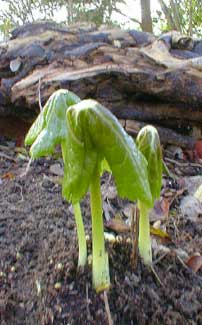
Himalayan Mayapple
"About 14 hundred May Apple stems,
With their parasols up, marched down the hill.
And all the Spring Beauties
turned up their pale, peaked noses
And said, "Don't them May Apples
Think they're somebody
With their bumbershoots up!"
Oh, it was a grand day, a specially grand day."
from "Beautiful Sunday"
by Jake Falstaff, Ohio
by Jake Falstaff, Ohio
Various species of Mayapples (or May Apples) are to be found throughout the northern hemisphere. Podophyllum hexandrum (formerly P. emodi) is the Himalayan Mayapple. Its fuller range in East Asia extends from Afghanistan to China & through the Himalayas.
Whether Mayapples return early or mid spring varies from plant to plant. In all the March & April photos on this page, a second May Apple growing only a couple of feet away is not yet in evidence. It is the same species planted in the same area, but it always pokes its first umbrellas up in May.
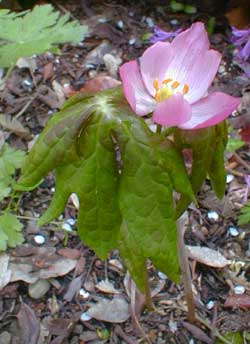 Before I got used to the second one's comparative tardiness, I fretted each spring it had rotted during the winter, since I could run my hands over the surface of the ground gently pushing leaf mould aside, finding no evidence of the other plant. But in some years by the end of April, other years not until mid-May, the tardy one inevitably pops out of the ground healthy as can be.
Before I got used to the second one's comparative tardiness, I fretted each spring it had rotted during the winter, since I could run my hands over the surface of the ground gently pushing leaf mould aside, finding no evidence of the other plant. But in some years by the end of April, other years not until mid-May, the tardy one inevitably pops out of the ground healthy as can be.Mayapple takes a couple of years to get established, then will spread rather aggressively by rhizomes, becoming a very substantial clump of large (ten inch) umbrella-leaves.
The umbrellas are at first small & folded, as in the first photo above, from March 2003. The third photo below was snapped a couple weeks later that same spring, in April, when the umbrellas were only a little shy of completely mature. The following year this same specimen did not reach the folded-umbrella stage until April. The second photo shows it in mid April (2004), with pink flower.
The lone flower is on cloudy days folded into the shape of a bright pink pyramidal bud. On warm bright days it opens as seen in the picture, facing upward.
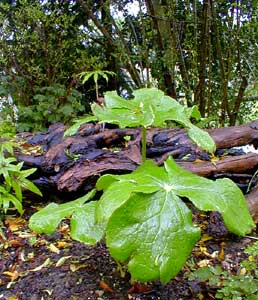 The flower does not last a long time. Almost as soon as it attracts a pollinator, the petals fall away, leaving a small green berry-sized beginning of what will eventually become a large (plum-sized) fruit. The leaves continue to get larger, so that the developing fruit is completely shaded & somewhat hidden.
The flower does not last a long time. Almost as soon as it attracts a pollinator, the petals fall away, leaving a small green berry-sized beginning of what will eventually become a large (plum-sized) fruit. The leaves continue to get larger, so that the developing fruit is completely shaded & somewhat hidden.As the green fruit (shown in the May photo below) ripens into summer, it turns to a bright red for P. hexandrum (as shown in the last July photo), or bight yellow for P. peltatum the North American Mayapple.
The leaves, flowers, & roots have a skunky or dungy odor which fortunately you have to get down close & bruise the plant to experience. It won't stink up the garden if unmolested.
The "apples" however have a wonderful odor, & are perfectly edible when ripe. However, they have a laxative effect so should be eaten sparingly. They taste halfway between a tomato & a paw-paw (Asimina triloba).
Until fully ripened the fruits are toxic. The plant overall is very poisonous & though used as an emetic in small quantities, in larger amounts it can cause death. The plant's bad smell if stepped on or crushed rather warns of this possibility. But the pleasant-smelling apples are intended to be eaten, because the plant wants its seeds distributed in animals' stool.
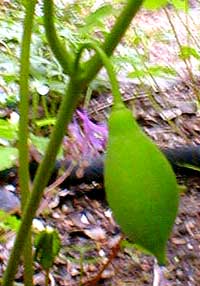 A number of double-blind clinical studies have been done on the medicinal values of the key mayapple chemical extracts, podophyllotoxin & podophyllin. These have been proven efficatious in some serious medical conditions, including temporary resolution of HIV-related oral hairy leukoplakia, effective topical treatment for penile warts, relief of some symptoms of rheumatoid arthritis, interferance with certain unhealthy cell cycles involved in leukemia, anti-tumor activity including for breast cancer treatment, & as a useful topical ointment to prevent scarring during healing after laser incisions.
A number of double-blind clinical studies have been done on the medicinal values of the key mayapple chemical extracts, podophyllotoxin & podophyllin. These have been proven efficatious in some serious medical conditions, including temporary resolution of HIV-related oral hairy leukoplakia, effective topical treatment for penile warts, relief of some symptoms of rheumatoid arthritis, interferance with certain unhealthy cell cycles involved in leukemia, anti-tumor activity including for breast cancer treatment, & as a useful topical ointment to prevent scarring during healing after laser incisions.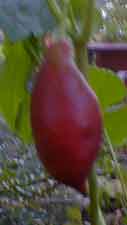 Such extreme healing value to some of humanity's worst ailments are claimed by herbal quacks for all sorts of powdered garden rubble totally useless beyond slight placebo effect, but where the mayapple is concerned, its potential usefulness has captivated a great many serious scientists.
Such extreme healing value to some of humanity's worst ailments are claimed by herbal quacks for all sorts of powdered garden rubble totally useless beyond slight placebo effect, but where the mayapple is concerned, its potential usefulness has captivated a great many serious scientists.But studies of the extracts' medical value does not imply that sick people should be eating bits of the poisonous root, leaves, & green fruit, which will at the very least cause nausea & vomiting, & could quite easily harm the liver, intestines, & pancrease, leading to violent painful death, unless you're lucky enough merely to be rendered comatose. For podophyllotoxin is a powerful, deadly neurotoxin.
Women using podophyllotoxin for any medicinal purpose during pregnancy risk birth defects for their children. Chinese herbal doctors have recommended its use for centuries, but also include in their literature examples of instances of the deadly effects on some patients.
As a garden ornamental, it likes moist well-draining soil & partial shade, but cannot be placed with delicate shade plants such as trilliums, smaller jack-in-the-pulpits, or dogtooth lilies, because its thick root system will displace anything the least bit sensitive. Our clump is separated from the jack-in-the-pulpits by a large & rather flat, ornamentally placed tree root, part of which is visible in the photos.